4th November 2019
Disgusted From Kimblewick
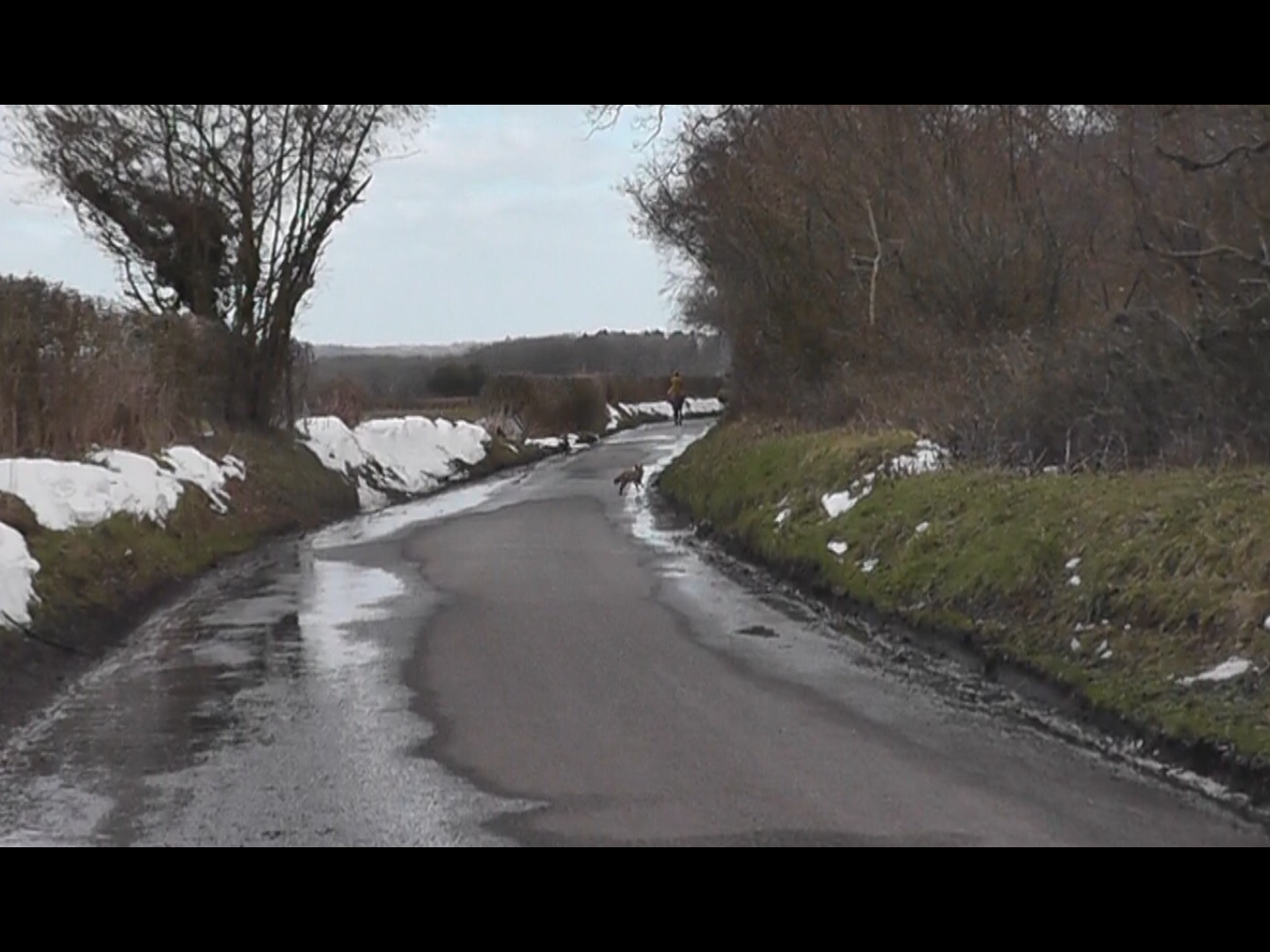 A fox hunted by the Kimblewick in 2018. They denied it but a recent conviction proves they are liars. Pic © Hounds Off
A fox hunted by the Kimblewick in 2018. They denied it but a recent conviction proves they are liars. Pic © Hounds Off
I always know when the Kimblewick Hunt is here before I see them. There’s an air of menace about and clues come from nervous wild animals I always see behaving differently to usual on hunt days. Clues build up during the morning; distant shouts, yakking, whooping, horn tooting and often the wail of hounds on cry shattering the usual peace of the countryside.
Quad bikes buzz across fields in the distance and there are more cars about, often driving in a procession, parked on verges and frequently blocking lanes as the small band of followers clamour to find the hunt.
If you’re unlucky you’ll see hounds streaming all over your garden - as happened to me - or running across roads (including A roads, on blind bends) or careering after panicked foxes, deer or hares. Although the Kimblewick’s primary target is foxes - as demonstrated by the recent conviction, I’ve witnessed them chasing all the aforementioned animals, often whilst trespassing on land that is forbidden to them. Some people might think that country residents support the Hunt and like to see them descend en masse: a spectacle, pageantry, tradition. The reality here is very different. I, and many other country residents, feel instead a sense of doom, dread and threat.
The Kimblewick is notoriously secretive. Local residents are not informed of their plans. Indeed, ask the farms and estates who continue to host them and I predict you’ll experience the same secrecy I do: “We will endeavour to let you know… we’re not sure when they’re coming… you’ll have to ask them yourself…” Odd, given that a spread is generally laid on for hunts and dates booked well in advance but nobody wants to reveal it. The host may let you know if you’re persistent (after all, should your pets be killed or another accident befall you, hiding that information won’t reflect well on them should it reach the press or social media) but it’ll be at the last possible moment, normally mere hours before they turn up. Could it be that the hunting community has something to hide?
It certainly seems so. Two members of the Kimblewick Hunt, Mark Vincent (their President, no less) and employee Ian Parkinson were convicted of animal cruelty last week after being filmed pulling a fox trapped in an artificial earth out by its tail before sending hounds after it on New Years Day. The huntsman can clearly be heard on the footage shouting ‘hold hard’-a hunting command which stops and holds hounds until they are released at the chosen moment (a good chase before the kill obviously being the objective; a quick kill is no fun).
The footage is sickening and has shown the rest of the country what most of us who live in the Kimblewick hunt’s country already know: so-called ‘trail hunting’ really entails hunting foxes as before the ban. Yet only two men have been convicted when it’s quite clear that this illegal act was committed as a joint venture amongst all present that day and was obviously planned.
Many landowners and residents object to the hunt, but many are also unwilling to openly protest. Hunt intimidation and influence is real, and the easiest option is to keep your head down and put up with it. Privately though, the talk is overwhelmingly negative when the issue comes up among friends and neighbours. One of my friends owns a retired horse who is partially sighted. The Kimblewick hounds have run through this disabled horse’s field on more than one occasion, causing significant distress to both horse and owner.
Living in the Kimblewick country can be an unpleasant experience. I have witnessed and reported their illegal hunting to Thames Valley police on several occasions but they failed to attend each time - including when Kimblewick terriermen blocked and threatened us on a public byway for daring to be out in my own local area when they were. Reasonable people have no desire to impose their will on others but hunting crosses the line of acceptability. It’s not only illegal, cruel and unnecessary, it poses a direct threats to pets, farm and wild animals. The sense of vulnerability and helplessness many of us feel is very real, as is the carnage we see on hunt days - not to mention the disease risk the Kimblewick failed to tell any of us about (97 hounds infected with bTB were shot at their kennels in 2017).
This case has proven the Kimblewick Hunt is engaging in organised wildlife crime. I appeal to everyone who hosts and facilitates the Kimblewick to withdraw. The Kimblewick should now disband, exactly as the disgraceful South Herefordshire hunt did after being filmed similarly throwing foxes to hounds. No farm, business or landowner can afford to be associated with such scandalous, despicable, illegal animal abuse.
© A Rural Resident From The Home Counties
15th March 2019
Somerset Churchyard Fox Hunt Excuses Rebutted
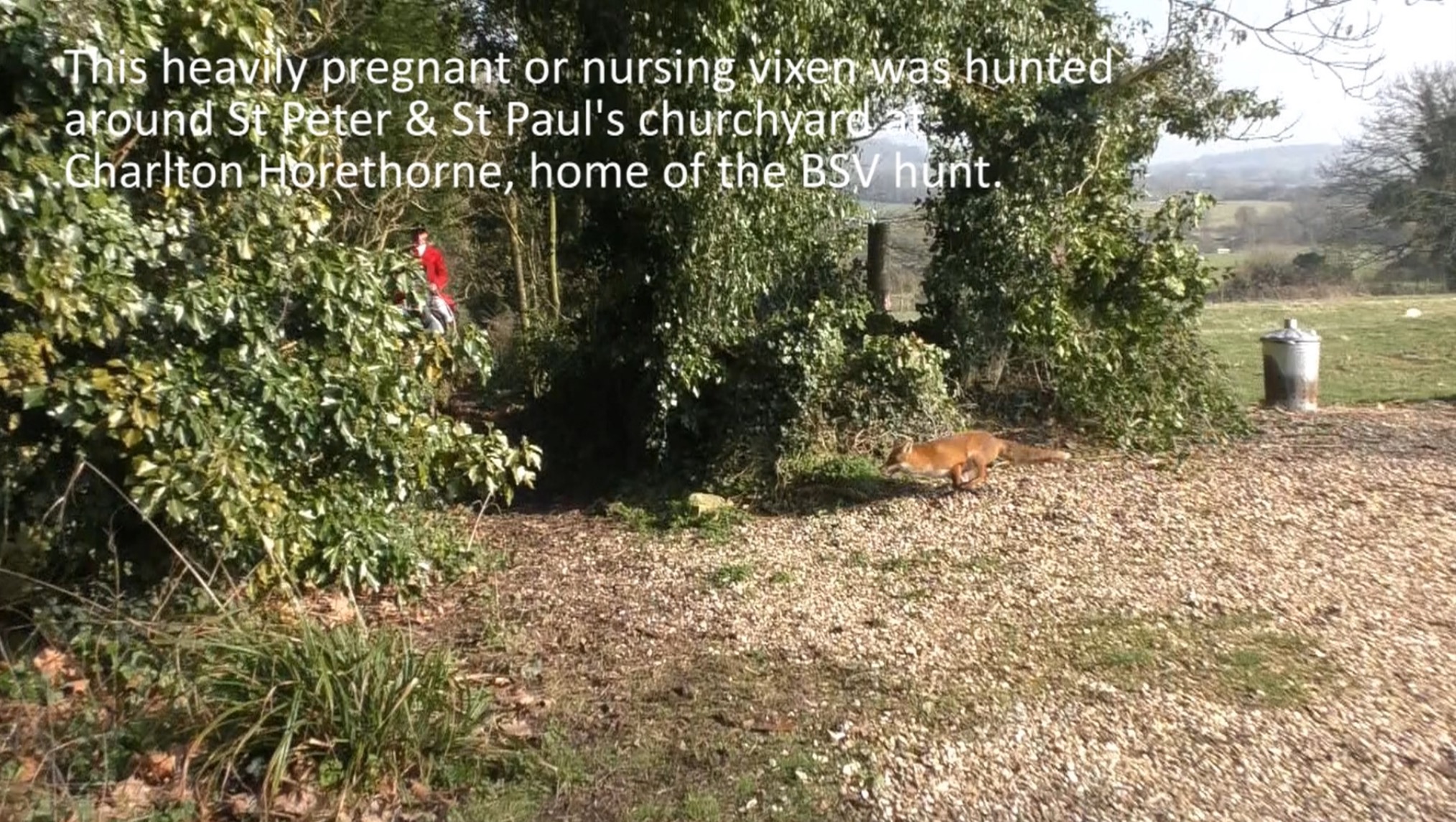 On 23.02.19 the Blackmore & Sparkford Vale Hunt were forced to call their hounds off a lactating vixen in a Somerset churchyard by Monitors who were at the scene. Responsibility for disturbing and hunting the fox rests completely with the hunters. © Somerset Wildlife Crime/Hounds Off
On 23.02.19 the Blackmore & Sparkford Vale Hunt were forced to call their hounds off a lactating vixen in a Somerset churchyard by Monitors who were at the scene. Responsibility for disturbing and hunting the fox rests completely with the hunters. © Somerset Wildlife Crime/Hounds Off
Regarding the recent incident involving the Blackmore & Sparkford Vale Hunt chasing a lactating vixen in a Somerset churchyard, a member of the public contacted the Hunt and asked them to explain why they were hunting a fox when foxhunting is illegal. She received the email we reproduce, below:
From: B&SV Secretary <bsvsecretary@XXXXXXXXX>
To: XXXXXX
Sent: Fri, 8 Mar 2019 19:10
Subject: Re: Recent footage of vixen being chased in graveyard
Dear Mrs XXXXXXXX,
Thank you for your email. The Blackmore and Sparkford Vale is committed to hunting within the law and does so through laying trails by people on horseback, on foot and on quad bikes. Occasionally as we progress through the countryside foxes and deer jump out in front of the hounds and if they deviate from the laid trail then we stop them at the earliest moment. We also have to contend with a number of anti-hunting activists watching us and trying to intimidate. Their tactics employed include spraying other scent on the ground, blowing horns and shouting to distract our hounds, which in turn confuses our hounds and renders our ability to control them that much more challenging. We believe that the film taken is not genuine and is deliberately constructed to discredit us, however clearly we would not normally be hunting anywhere near a graveyard and regret that the actions by the anti-hunting activists caused some hounds to go through the church grounds.
Kevin Hill (tel: 07971 633182) was one of the Hounds Off/Somerset Wildlife Crime team who witnessed and filmed the Charlton Horethorn incident. Kevin is one of the most experienced Hunt Monitors in the country with nearly 40 years under his belt. We asked him to comment on the excuses made by the Hunt:
- As demonstrated in the video from the Charleton Horethorne churchyard, Blackmore and Sparkford Vale Hunt staff seem to exercise selective control over their hounds. They can control hounds very effectively when it suits them.
- Monitors present witnessed the hounds being hunted on to a fox under the supervision of hunt staff. There were no attempts to draw them out of the cemetery or away from the fox which was clearly visible and holloa’d by several hunters and supporters.
- Hunt staff only exercised adequate control over their hounds when asked by one of the Monitors present to call them off the hunted vixen. When faced with two video cameras the Whipper-In (second in command to the Huntsman) was left with little choice but to comply. This proved to be the vital moment that saved the vixens life.
- We do not accept that the presence of any anti hunt Monitors would prevent hounds from being controlled efficiently. This is especially true when hounds are in close proximity to the Huntsman or Whipper-In, as was the case in this incident.
- No hunt saboteurs were present in the cemetery or immediate area on the 23rd February, when this incident happened.
- Footage is available that shows the Monitors present made no attempt to disrupt hounds with any calls, voice or horn and no scent dulling sprays were utilised. Claims to the contrary are merely an attempt by the hunt to dilute the validity of any allegations against them.
- We invite the Blackmore and Sparkford Vale to comment in detail as to exactly what the allegations laid against the Monitors who were present are. We would be most interested to see any footage to support any claims that hounds were called into the cemetery.
- As Monitors we maintain a passive presence with the hunt throughout the day and film proceedings. This can be useful on an evidential basis of any trespass or illegal hunting. As proven on the 23rd February in Charlton Horethorne, filming can often serve to save life when the hounds would otherwise be permitted to continue hunting unhindered. Our footage is available to be viewed here. It is worth noting that a member of hunt staff in a red coat is seen observing the hounds in the cemetery from the road side and makes no efforts to call them out.
Read our original Press Release here.
Footage of the Blackmore & Sparkford Vale Hunt chasing a fox at Folke Church in Dorset on 22.12.18 can be viewed here.
Hounds Off/Somerset Wildlife Crime, without prejudice
3rd March 2019
Staghunting: And So It Continues…..
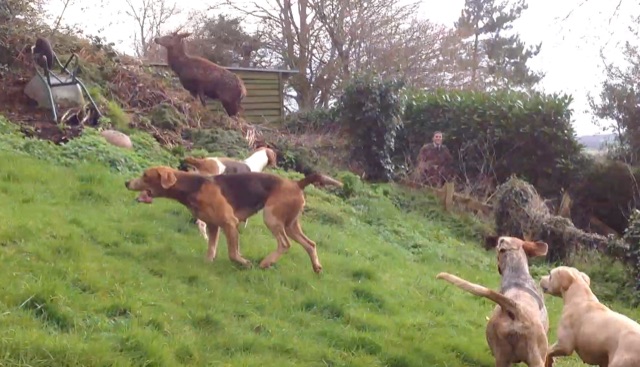 Stag at bay on a compost heap in a private garden adjacent to National Trust property on the Quantock Hills, March 2017. Photo © Hounds Off, with permission only
Stag at bay on a compost heap in a private garden adjacent to National Trust property on the Quantock Hills, March 2017. Photo © Hounds Off, with permission only
March 1st is when Spring Staghunting starts on the Quantock Hills and Exmoor. ‘Spring’ stags are the young adults, the stags with most energy and va-va-voom. These are a staghunters favourite quarry because they run hard, fast and long. For those who delight in chasing then killing fit and healthy Red deer then March and April are the most exciting months of the year.
Two years ago Teresa, a Quantock Hills resident, contacted Hounds Off and told us her story.
Teresa was in her kitchen. It was just after lunchtime. She could hear the Quantock Stag Hounds hunting really close and then saw out the window a hound by her garden pond. She grabbed her iPad to and went outside to take some film. The noise was suddenly deafening. There was a stag in her garden, up by the summerhouse. Other hounds were in the garden too and the stag moved towards the compost heap.
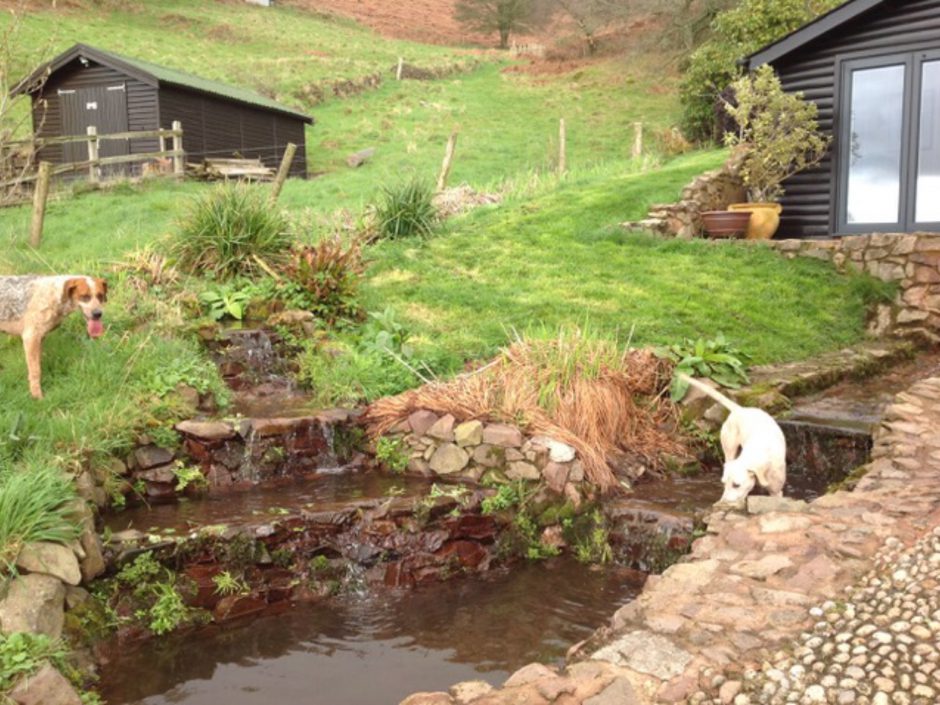
Hunting dogs from the Quantock Stag Hounds by Teresa’s garden pond. © Hounds Off, with permission
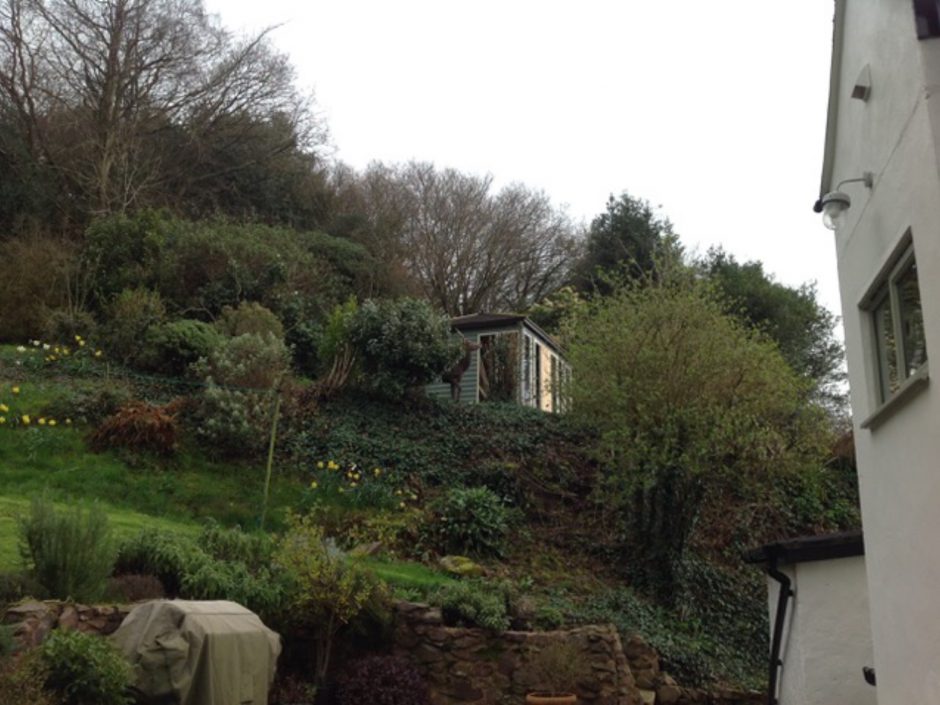
The hunted stag by the summerhouse © Hounds Off, with permission
A huntsman was just beyond the garden fence. He asked Teresa for permission to shoot the stag and she said, “No”. She asked the man his name and what he was doing. He said that she didn’t need to know. More hounds came in to the garden. Teresa reckoned there were about seven but they were hard to count because of so much movement.
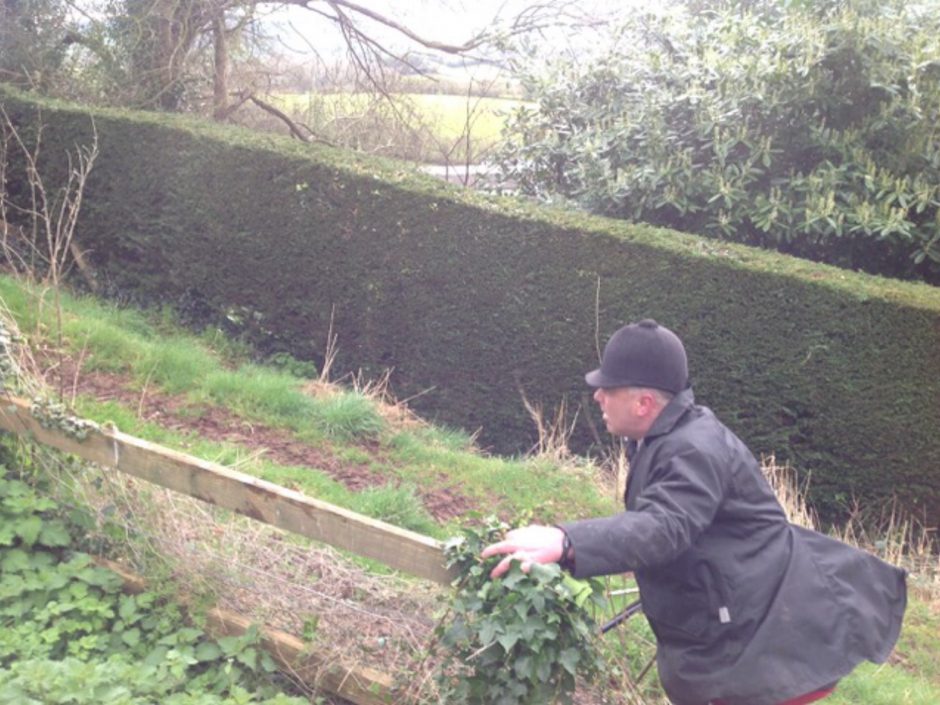
Teresa refused to let the Quantock Stag Hounds Huntsman shoot the stag in her garden. © Hounds Off, with permission
By now the stag had climbed on top of the compost heap. There were riders looking down from the hill up above and conversations could be heard between unseen hunters on walkie-talkies. Numerous vehicles were parked on her private entrance drive with people standing and watching.
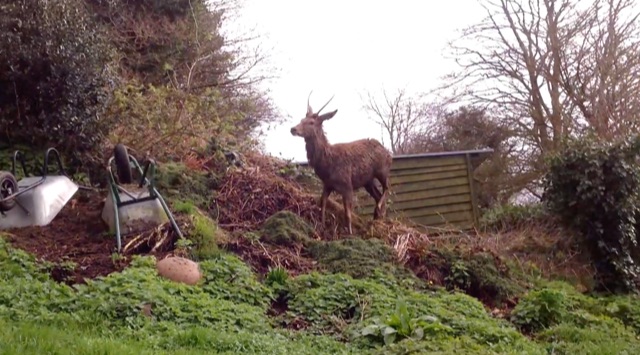
The hunted stag on the compost heap, using the height for protection. © Hounds Off, with permission
Suddenly there were four burly men at close quarters. The man who wanted to shoot the stag warned Teresa not to interfere in case the dogs attacked her. She was frightened because, as she told us afterwards, “I was outnumbered and could see that their blood was up.”
The dogs had chased the stag off the compost heap but he returned and was again at bay.

Stag at bay on a compost heap in a private garden adjacent to National Trust property on the Quantock Hills, March 2017. Photo © Hounds Off, with permission only
Teresa said, “The stag was surrounded by hounds and huntsmen and was clearly exhausted and petrified. I felt I needed to protect it. I felt strongly that it was not just right that I protect it, but it was my right to protect it. Not just because I don’t agree with hunting with dogs, but because it was in my garden and I should have been able to save it. My garden was its sanctuary.”
Again, she told the hunters to call their hounds off. One young, thick-set individual threatened to call the police because he said she was “harbouring a deer.” He also threatened to call the RSPCA, shouting that the stag was injured and had to be killed. But they did manhandle their dogs over the fence and remove themselves as well.
Another man who Teresa didn’t know or recognise appeared. He also refused to identify himself and joined the other hunters. They huddled together and then, right in front of Teresa, stormed into her garden, ran towards the stag and physically pushed it off the compost heap, over the fence and away towards private farmland. The men and their dogs, the riders and the people in cars all followed in different directions as fast as they could.
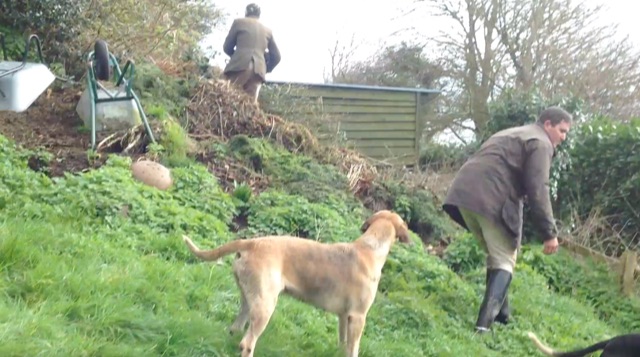
Quantock Stag Hounds men and dogs trespassed with menace to get the hunted stag running again. © Hounds Off, with permission
Teresa was totally shocked and shaken. She immediately called the police to report the incident.
A couple of hours later two huntspeople called at the house. Only one of them would give his name. He said that they were “trailhunting” with eleven hounds when unfortunately this young, injured stag jumped up in front and caused a distraction. They decided to kill it because, apparently, it was injured. Their excuses were not believed and apologies not accepted.
“A day later the Huntsman left a message to tell me the stag had been previously shot by a .22 rifle. I learnt later from the police it was in the chest,” Teresa recalled, “But this exposed them as liars. I was stood ten feet away from the stag for some time. There was no injury to the chest, old or new, but it was exhausted. I didn’t realize it then, but subsequently I found out that they have used this excuse before to exploit a loophole in the Hunting Act. I thought at the time that it was a really odd thing to say that they would call the police because ‘I was harbouring a sick deer’, but I later realized that they worked out which angle they were going to use to get out of this, hence why they didn’t care about me filming.”
Avon & Somerset Constabulary completely failed to take Teresa’s allegation of illegal hunting seriously and it appears that there was a deliberate block put on conducting even a cursory investigation. The Quantock Stag Hounds got away with it. But we helped call the police failures to account. Crucially, over a year later their own Professional Standards Department upheld six out of nine points of complaint.
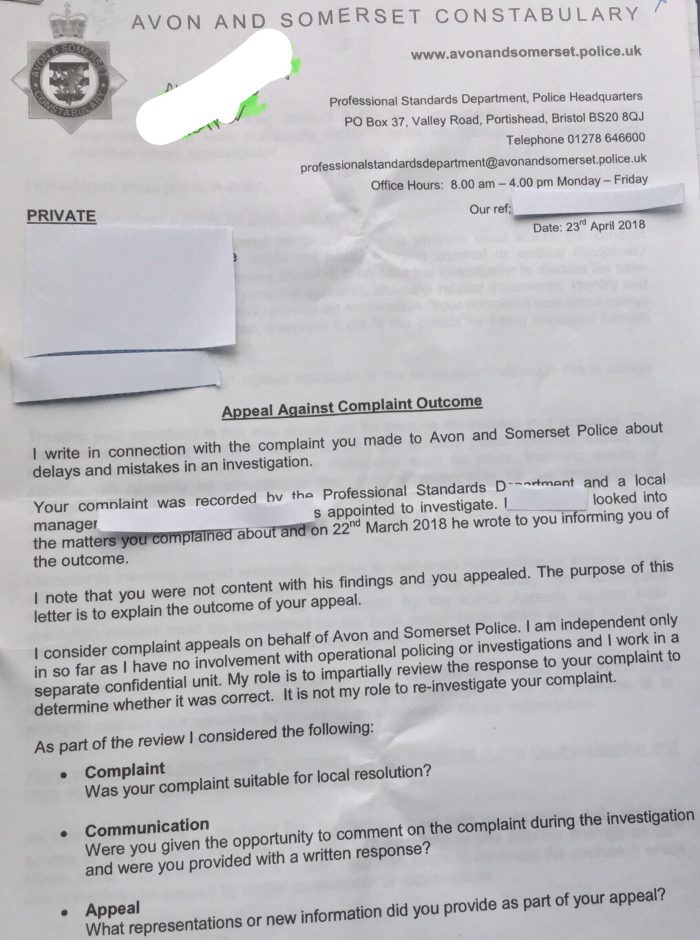
First of a seven page letter upholding six out of nine points of complaint made by Teresa. © Hounds Off
Teresa said, “When I reflect back with the knowledge I have gained over the last two years, I know that the Hunting Act has to change. Any reasonable person looking at the facts knows exactly what these hunts are up to. But the legal system is choosing to ignore the test of the reasonable person. As it stands today it is almost impossible to prove illegal hunting and get a conviction.”
Her immediate neighbours are the National Trust and she feels let down by them, too. Despite receiving all the evidence and her witness statement, and despite the fact that they themselves banned deer hunting with dogs on their land in 1997, the Quantock Stag Hounds frequently hunt across forbidden land. As recently as January 28th this year they held a fundraising meet and then hunted on National Trust land. Clearly this is unacceptable and we are in dialogue with the Trust to work out how to prevent future arrogant flouting.
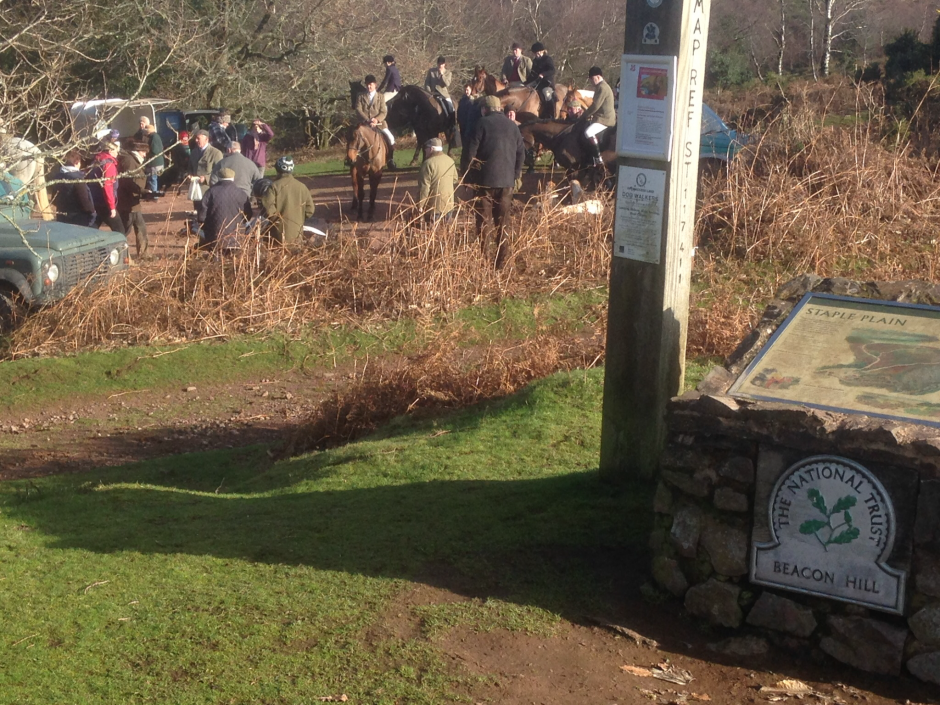
Members of the Quantock Stag Hounds meet on National Trust land at Beacon Hill Car Park, Staple Plain, West Quantoxhead, Somerset on Monday 28 January 2019. The National Trust banned all deer hunting with dogs from their properties in 1997. Photo © Hounds Off
Rural residents have turned to us in desperation and we answered their call. Our tactics are simple; in partnership with Somerset Wildlife Crime and individuals, groups and organisations who want to work with us, we’re shining a light on modern day staghunting. Please see the following links for more details:
- Your Membership (of the National Trust) And Voice Matters
- Staghunting On The Quantock Hills 08.10.18
- Press Release: Staghunting In Somerset, October 2018
- Nowhere To Hide
- Another Wretched day With The Quantock Stag Hounds
- Quantock Stag Hounds Meet Fundraise Hunt On National Trust Land 28.01.09
- How To Report Hunt Incidents To The National Trust
- Stag Hunters Break Convention To Ensure Valentines Day Sport
- Quantock Stag Hounds After Another One
Please consider . We couldn’t do what we do without you.
© Joe Hashman. Founder; Hounds Off
16th February 2019
Staghunters Break Convention To Ensure Valentines Day Sport
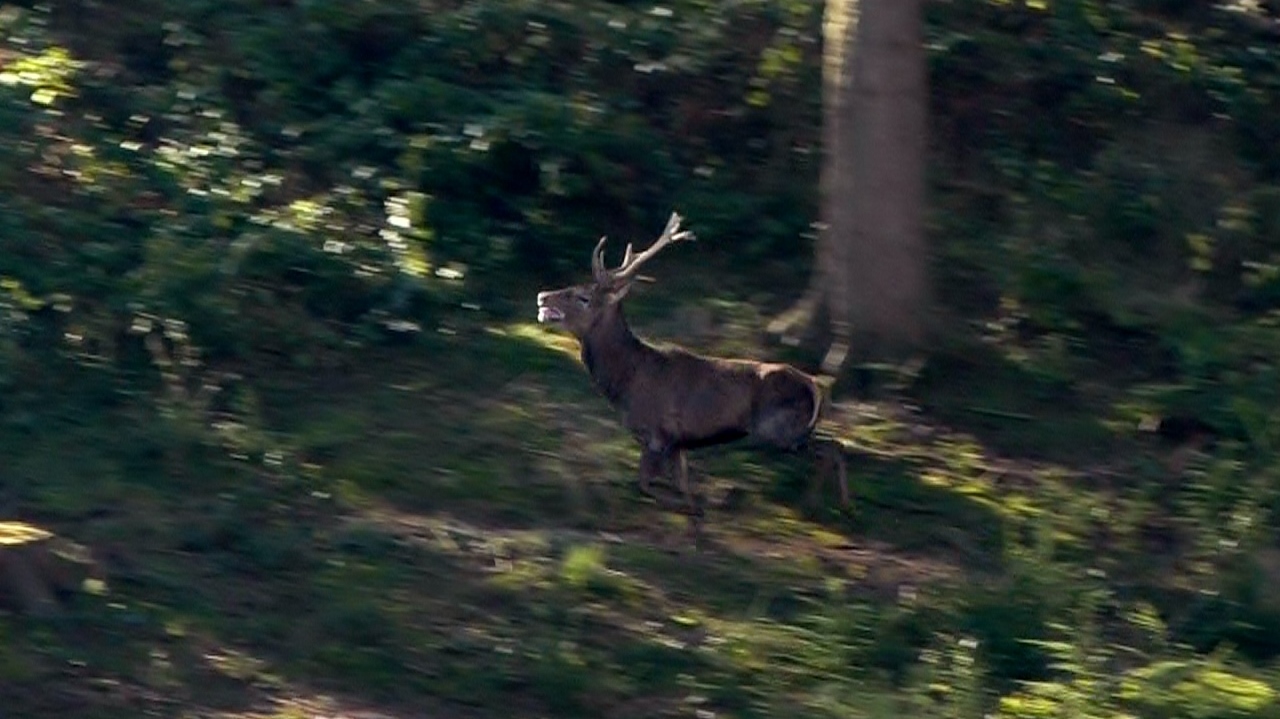 Hunted by the Quantock Stag Hounds on Valentines Day 2019. With no female deer (hinds) in the area, hunters told us this animal was selected because it had a "displaced hip". We question the honesty of their claim because this stag ran for miles across open country and escaped to see another day. Read more, below. Photo: © Kevin Hill/Hounds Off
Hunted by the Quantock Stag Hounds on Valentines Day 2019. With no female deer (hinds) in the area, hunters told us this animal was selected because it had a "displaced hip". We question the honesty of their claim because this stag ran for miles across open country and escaped to see another day. Read more, below. Photo: © Kevin Hill/Hounds Off
Hunters claims that a Red deer stag chased by the Quantock Stag Hounds on Valentines Day was suffering from hip displacement have been seriously questioned by observers. The creature was chased for over two miles as the crow flies, many more as they ran, between 1.30pm and 3.30pm. In the moments before the hunt ended, huntsman and hounds were seen to be fruitlessly trying to find the stag in field hedges near the West Somerset village of Clatworthy.
Experienced Hunt Monitor Kevin Hill, who was part of a team of volunteers from Somerset Wildlife Crime and Hounds Off, filmed the allegedly injured stag in the old slate quarry woods below Brompton Ralph. He said, “The stag looked in good shape to me. He travelled through the woods jumping felled trees!”
The claim that the stag was injured was made to Mr Hill by hunt followers when he asked them why a male Red deer was being pursued at a time of year when females are the traditional target.
Somerset Wildlife Crime and Hounds Off Monitors believe that this was just an excuse because the hunt couldn’t find any females to chase. They only saw stags, roe deer and a fox roused into flight by hounds. That hinds are quarry from November through February is just hunting convention and, on this occasion, in order to get some ‘sport’ it had to be broken.
© Joe Hashman
Support what we do? Keep our service sustainable & volunteers in the field - buy us a Ko-Fi;
Hounds Off
Somerset Wildlife Crime
10th February 2019
Hunters Disregard Horse Welfare
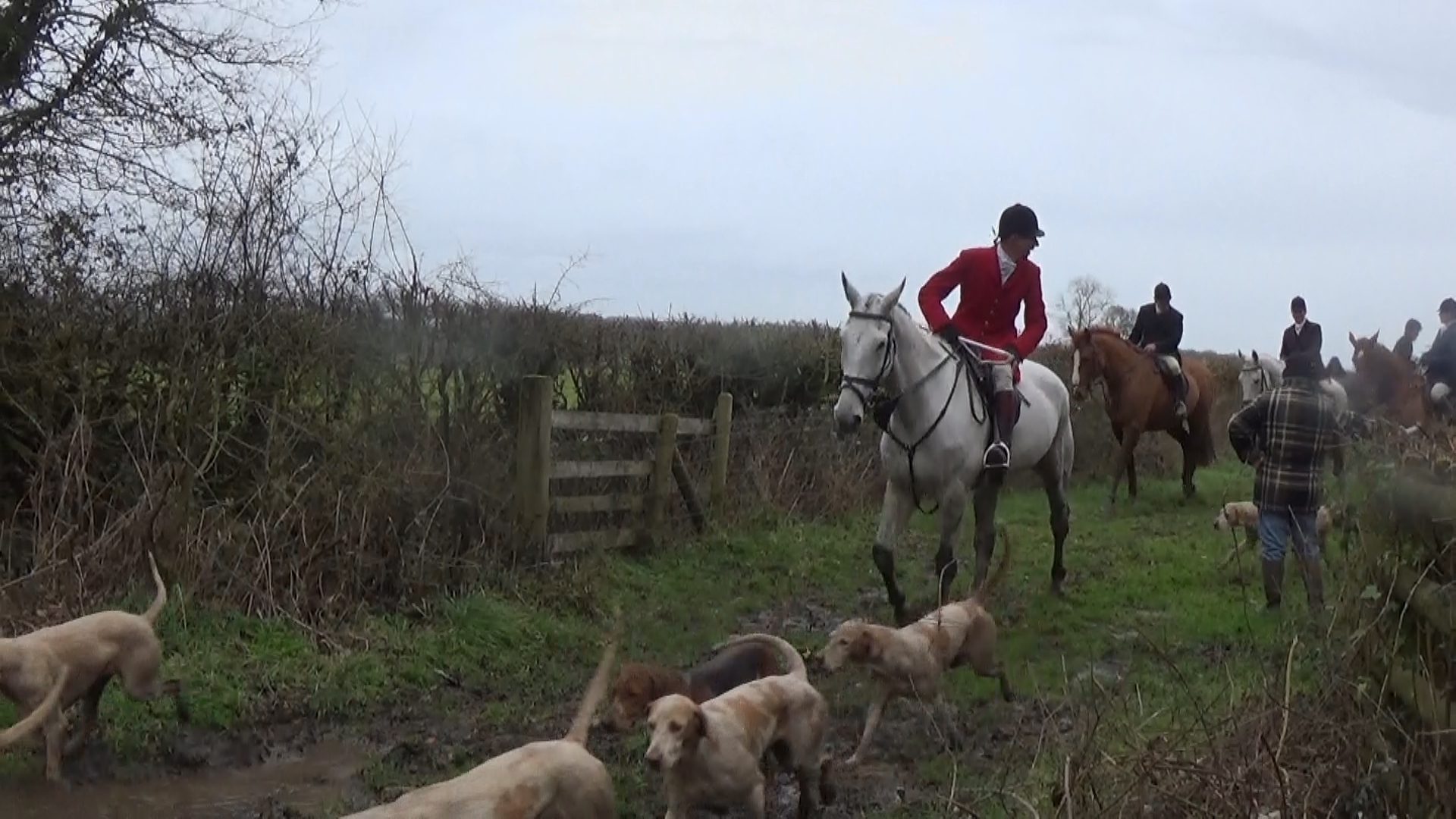 About 70 riders followed the Blackmore & Sparkford Vale Hunt from their meet at Marsh Court in Dorset on 09.02.19, contrary to biosecurity advice from The Hunting Office with equine flu at large. Photo © Hounds Off
About 70 riders followed the Blackmore & Sparkford Vale Hunt from their meet at Marsh Court in Dorset on 09.02.19, contrary to biosecurity advice from The Hunting Office with equine flu at large. Photo © Hounds Off
BREAKING: PRESITIGIOUS SOMERSET STABLES CONFIRMS EQUINE FLU BUT LOCAL HUNT CARRIES ON REGARDLESS
Horse racing was suspended last week after an outbreak of equine flu at a Cheshire stables. Equine flu is a highly contagious and unpleasant viral infection which affects the respiratory system in horses. Explaining its decisive action, the British Horseracing Authority said (7 Feb), “The health and welfare of our horses must be a priority.”
It is unfortunate that some of the hunting world has chosen to carry on regardless.
Despite Horse & Hound reporting (8 Feb) advice from The Hunting Office*, “Where there are training yards in the area it may be sensible not to hunt this weekend,” it was actually business as usual for many mounted foxhound packs across the British Isles (9 Feb).
One such hunt was the Somerset-based Blackmore & Sparkford Vale, where about seventy riders turned out on horseback to gallop behind dogs chasing the scent of foxes. Blackmore & Sparkford Vale Hunt country is known for having some big stables, including Paul Nicholls Racing at Ditcheat, Colin Tizzard Venn Farm Racing Ltd at Milborne Port and Millfield School at Street where equine flu was confirmed on 8 Feb.
Hounds Off Founder Joe Hashman said, “If the Blackmore & Sparkford Vale Hunt genuinely cared about the health and wellbeing of horses they’d have suspended all mounted hunting immediately. The fact that they have chosen to carry on hunting demonstrates how prepared they are to put horses at risk rather than lose a days play.”
© Joe Hashman; Founder, Hounds Off
* The Hunting Office is the administrative hub for the Council of Hunting Associations. The Hunting Office exists to help and advise Masters and its member Hunts. It represents and supports packs of hounds from fourteen hunting associations in England, Scotland and Wales, providing advice on all matters regarding hunting activities, hunt management and hound health & welfare.
25th January 2019
Hounds Off ‘Sleeping Fox’ In Stained-Glass
 Hounds Off 'Sleeping Fox' stained-glass window by Paul Snell (20.5cmx20.5cm)
Hounds Off 'Sleeping Fox' stained-glass window by Paul Snell (20.5cmx20.5cm)
A beautiful Hounds Off ‘Sleeping Fox’ stained-glass window can be hand-crafted specially for you by our wonderful, talented supporter Paul Snell. Each one measures 20.5cm square and will arrive securely packaged to your home four to six weeks after placing your order, complete with a small length of chain for hanging purposes (if you don’t live in an actual church).
Hounds Off ‘Sleeping Fox’ stained-glass windows by Paul Snell cost £70 each plus £6.50 postage & packing.
£10 from each sale to helps fund our work offering help, support and advice to farmers, landowners and rural residents affected by hunt trespass.
If you would like to own one of these bespoke creations then we would all be delighted. Our preferred methods of payment are either bank transfer or cheque, to avoid charges.
Send cheques payable to ‘Hounds Off’ for £76.50 to Hounds Off, PO Box 162, Shaftesbury, Dorset SP7 7AZ. Don’t forget to include your address.
Bank transfer £76.50 to us: Sort Code 09-01-27, Account Number 90028160. Ref: ‘Glass Fox’.
But of course we accept PayPal too. If this is how you’d like to do the money thing then please pay £80 (to cover the extra charges) into our account; [email protected] (ref: ‘Glass Fox’ please).
When a friend tagged us in to a Facebook post which Paul had uploaded, showing the first Sleeping Fox stained-glass window in process, we were genuinely moved by the effort and care being taken over representing our much-loved logo in this way. And it feels appropriate to give a respectful nod towards the man who brought our vision to life in the first place, Boo & Stu artist Stu Jones.
#foxylove
Joe Hashman, Founder; Hounds Off
14th December 2018
Hunting Myths Pt 7: Snakeoil Salesman’s Last Stand
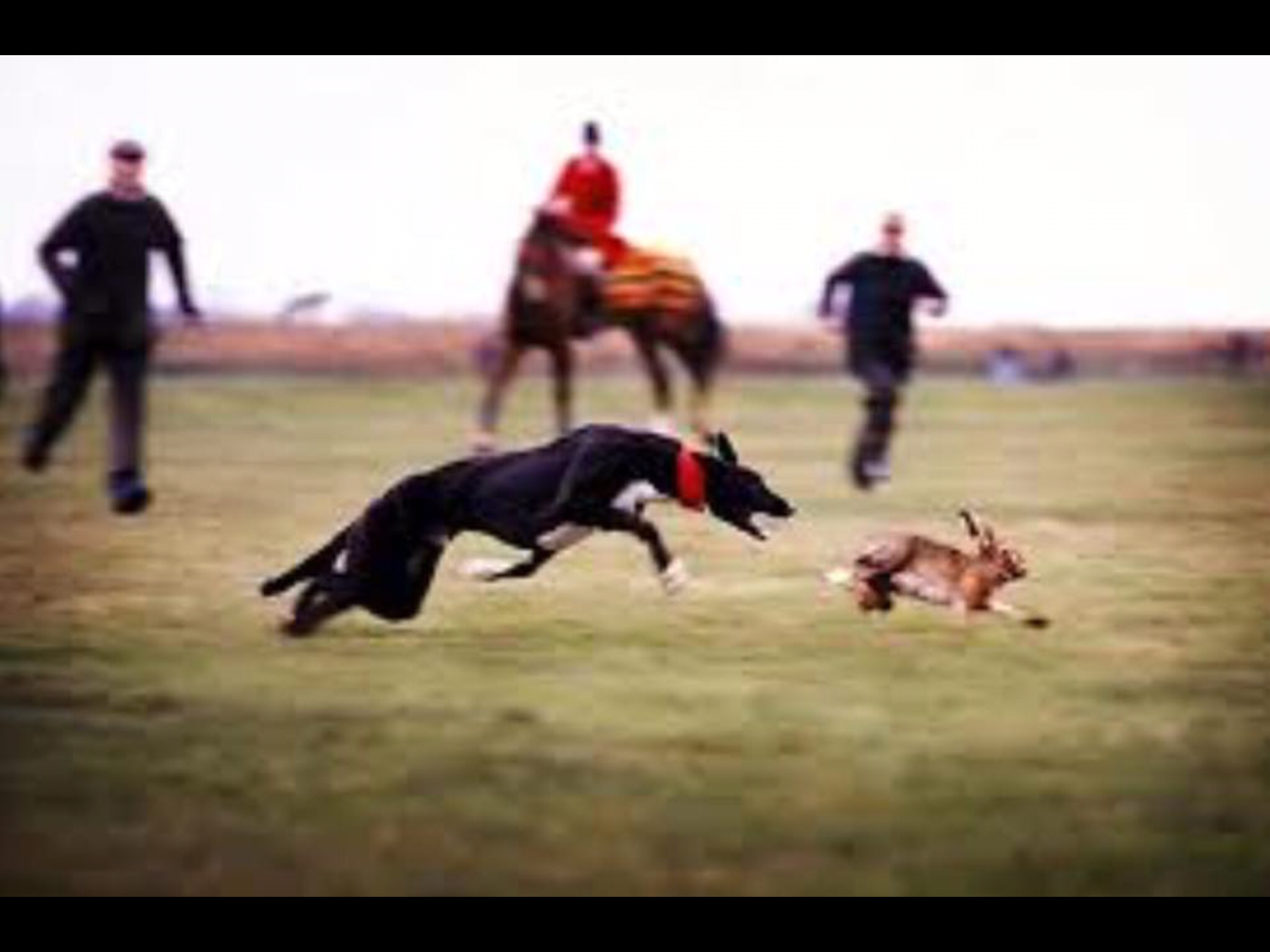 Who in their right mind could approve of the so-called "sport" of hare coursing, where hares are forced to run for their lives in front of greyhounds (or similar fast running dogs) while spectators gawp, bookies profit and officials judge and award points for every twist, turn, trip and kill? Photo credit: Ed Maynard.
Who in their right mind could approve of the so-called "sport" of hare coursing, where hares are forced to run for their lives in front of greyhounds (or similar fast running dogs) while spectators gawp, bookies profit and officials judge and award points for every twist, turn, trip and kill? Photo credit: Ed Maynard.
Zoologist Jordi Casamitjana writes exclusively for Hounds Off
Mr Barrington and the Countryside Alliance keep saying it’s a myth that the majority of the population is against hunting (Horse & Hound, 11.10.18). They often refer to particular attendance of anti-hunting or pro-wildlife events as evidence. The truth is that in the last two decades there has not been any single poll that has not shown a majority of a UK population being against hunting. This must be quite hard to swallow for Mr Barrington because, despite all his efforts, the percentages of people against hunting keep rising. It’s well over the 80% mark now.
Of course he will now claim that polls undertaken by reputable polling companies using big random samples don’t show the reality of public opinion, suggesting instead we should just count how many people have attended a particular hunting protest or Parliamentary reception, then conclude those are the only people opposing hunting. And, of course, if he continues to ignore science it would not be surprising if he said that if no “antis” have attended a packed hunting ball or a pro-hunting countryside event, this must mean the anti-hunting sentiment has vanished and people in the UK now wants hunting back (which is kind of what he implies in the Horse & Hound article).
Mr Barrington also must be very frustrated when again and again attempts to repeal or weaken the Hunting Act 2004 have failed because a dwindling number of pro-hunt MPs, even during Conservative Governments.
I am sure he will not give up, though, as he has a job to do, so he will continue trying to deceive on-the-fence MPs (or MPs that are secretly pro-hunt) into believing that he can offer a supposedly “middle way” between the two sides of the hunting debate (as he did during the debate for the passing of the Hunting Act 2004).
Some MPs may fall into this as he will do that by disguising the repeal of the hunting ban with a new “Wild Mammals Protection Bill”, which will sound good, as will talk about protection of mammals and banning some horrible practices … but in the end it will introduce a licensing system which will allow only a “select” group of “experts” to undertake wild mammal “lethal” control … and you know who he will be referring to, don’t you? Yes, registered hunts, of course.
Fortunately, it would not take that much for those deceived politicians to realise the trap they were about to fall into. But it is important we keep vigilant and help them to avoid falling and persuade them instead to support any initiative to strengthen the Hunting Act 2004 and the Protection of Wild Mammals (Scotland) Act 2002, to eliminate all the loopholes (such as the “flushing to guns” or the “observation and research” exemptions) and false alibis (such as “trail hunting”) which hunts constantly use to circumvent the law.
It’s not surprising that the rejection of hunting by the UK population, both rural and urban, in any constituency in the UK, is denied by Mr Barrington and colleagues. This is classic “denial”, which I am sure he has to do as part of his job … but he must know by now that there is no way back, for hunting, and for him.
If Mr Barrington is indeed “hunting‘s most valuable asset” we just need to be sure he doesn’t get away with false claims and sneaky political manoeuvres and keep him “at bay” every time he surfaces. Hunting with dogs is an obsolete cruel activity and eventually will be completely abolished, no matter which “assets” are used to derail this unstoppable social progress.
© Jordi Casamitjana
Zoologist
PREVIOUSLY
Hunting Myths Pt 1: The Snakeoil Salesman
Hunting Myths Pt 2: They Only Go For The Sick Old & Weak
Hunting Myths Pt 3: Hunting Is Efficient & Humane
Hunting Myths Pt 4: Hunting Is Natural
Hunting Myths Pt 5: Hunting Conserves The Countryside
Hunting Myths Pt 6: Hunting Is Wildlife Management
13th December 2018
Hunting Myths Pt 6: Hunting Is Wildlife Management
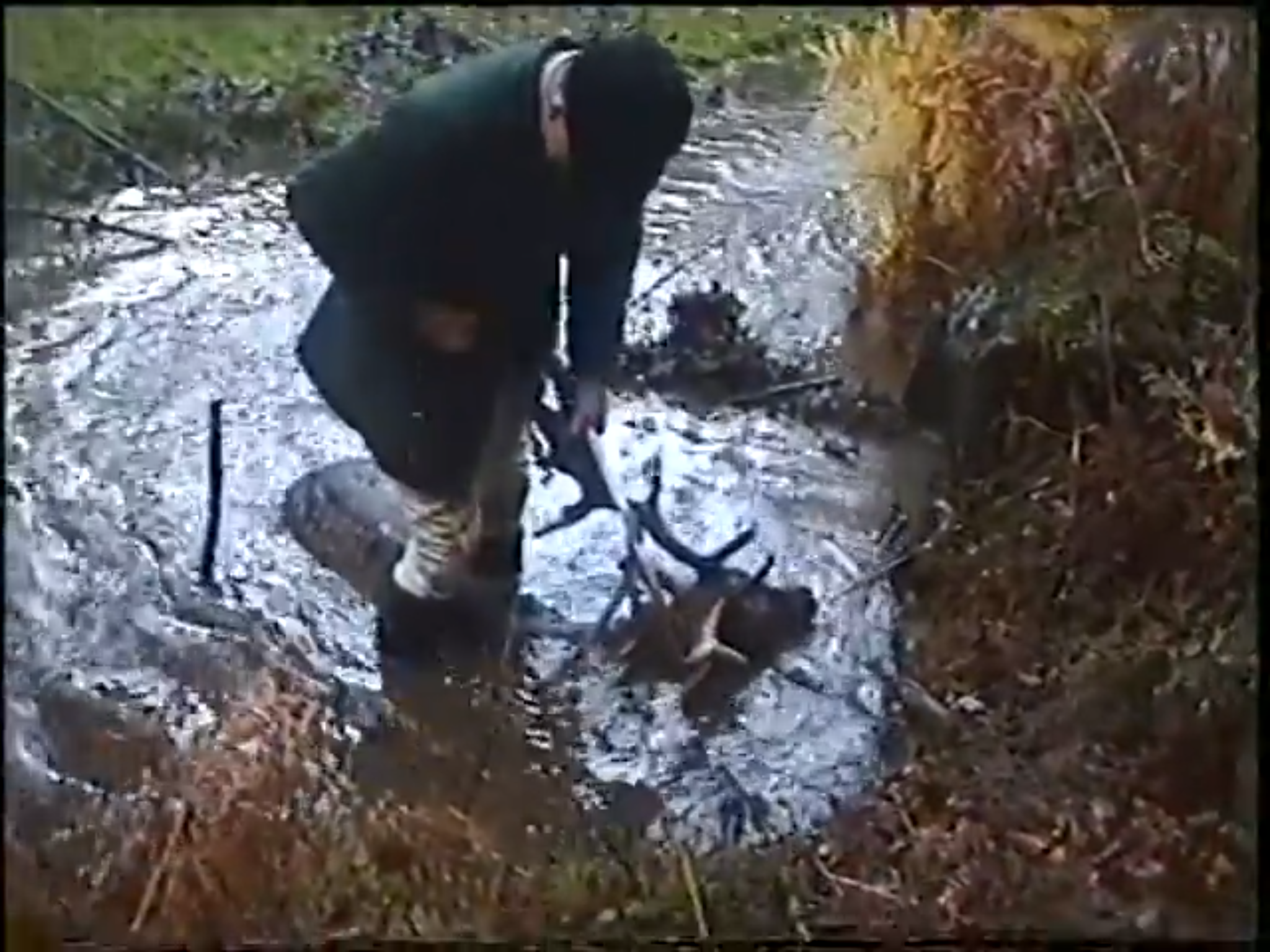 Pest Control, wildlife management or simply a cruel sport which made some money & satisfied the bestial urges of a sadistic minority? Here, now defunct New Forest Buckhounds Huntsman John Stride fumbles in his pocket for a gun whilst straddling an exhausted fallow buck run to collapse in a stream. Stills from a film taken in 1995 by Wildlife Action.
Pest Control, wildlife management or simply a cruel sport which made some money & satisfied the bestial urges of a sadistic minority? Here, now defunct New Forest Buckhounds Huntsman John Stride fumbles in his pocket for a gun whilst straddling an exhausted fallow buck run to collapse in a stream. Stills from a film taken in 1995 by Wildlife Action.
Zoologist Jordi Casamitjana writes exclusively for Hounds Off
Perhaps the claim that wild animals need to be lethally managed by people is the most crucial false argument Mr Barrington uses in his rhetoric (Horse & Hound, 11.10.18). He always tries to get others to accept this claim before he then moves with the claim that ‘if they need to be killed, better do it with dogs’. But the truth is that in most cases, wildlife doesn’t need to be managed. In most cases, natural ecosystems (and the wildlife in them) need to be preserved by preventing humans’ interference and letting Nature to find its own balance. And in the cases where Nature needs a helping hand because we humans have messed the ecosystem too much, there are plenty of feasible wildlife management methods that are not lethal, and therefore are not based on killing wildlife (such as fencing, shepherding, translocations, management of available food, deterrents, etc.).
Unfortunately this dangerous idea that killing is necessary to succeed is very much entrenched in the minds of many landowners, from farmers killing wildlife around their land to protect their ‘products’, to shooting estates eliminating predators of the animals they want to sell as live targets for the guns, to conservation organisations obsessed with the preservation of a particular species and wanting to kill other animals that compete with them.
As such, non-lethal methods of wildlife management are often ignored and unnecessary killing is chosen when it should have been avoided. This accounts for the examples Mr Barrington uses in the article, which he uses as either examples of compulsion (‘it needs to be done’) or hypocrisy ( ‘we have to do it but we want to keep it secret’), as if somehow validates such practices. These examples of Mr Barrington’s lethal ideas are so dangerous that even some organisations which should be protecting animals are unfortunately (and erroneously) seduced by them, causing much unnecessary suffering and death.
In the case of foxes it is particularly true that they don’t need lethal control, as a lot of research has already proven that the fox population is not growing out of control, and their ‘negative’ effect on farming has been greatly exaggerated. Research has already shown how little foxes contribute to lamb predation and that it is likely that when a shepherd finds evidence of a fox eating a lamb this may be because the lamb died from other causes. The fox is just being a scavenger.
And foxes who take advantage of poor human husbandry by getting into henhouses do not kill more than they can eat at one sitting for the sheer fun of it. ‘Surplus killing’, as it is known, is a survival technique which has evolved in foxes to guard against future food shortages.
Fox populations self-regulate because they are composed by territorial animals, so the populations are kept more or less stable if the space and food availability does not change. And if there is a problem with a particular fox, killing it may make it worse. If farmers remove an older fox with any lethal wildlife management method because they consider this fox ‘vermin’ another young fox will replace it very soon after as the territory become vacant and no longer defended by the older fox. This new fox is most likely to be more ‘problematic’ to farming as it is likely to be more inexperienced and not know the territory well, venturing more into places it is not welcomed (the areas where livestock are kept), and thus making the ‘problem’ even worse.
In Mr Barrington‘s article it is claimed that hunting provides a huge level of controlled public access to private land, but everyone who has attempted to monitor hunting knows how false this is. It is precisely the fact hunts these days use much private land which the public are not allowed to enter which allows them to hunt illegally with impunity, as it is difficult to obtain evidence without such access. Hunt supporters don’t hesitate to prevent public access to rights of way and common land because they fear that anyone who does not belong to their fraternity may end up reporting them to the authorities when they witness what they actually do.
From blocking roads with their vehicles to physically assaulting bystanders, the hunting fraternity is well known for their intimidation and violent tactics towards the general public, so this claim is quite ludicrous.
© Jordi Casamitjana
Zoologist
PREVIOUSLY
Hunting Myths Pt 1: The Snakeoil Salesman
Hunting Myths Pt 2: They Only Go For The Sick Old & Weak
Hunting Myths Pt 3: Hunting Is Efficient & Humane
Hunting Myths Pt 4: Hunting Is Natural
Hunting Myths Pt 5: Hunting Conserves The Countryside
10th December 2018
Hunting Myths Pt 4: Hunting Is Natural
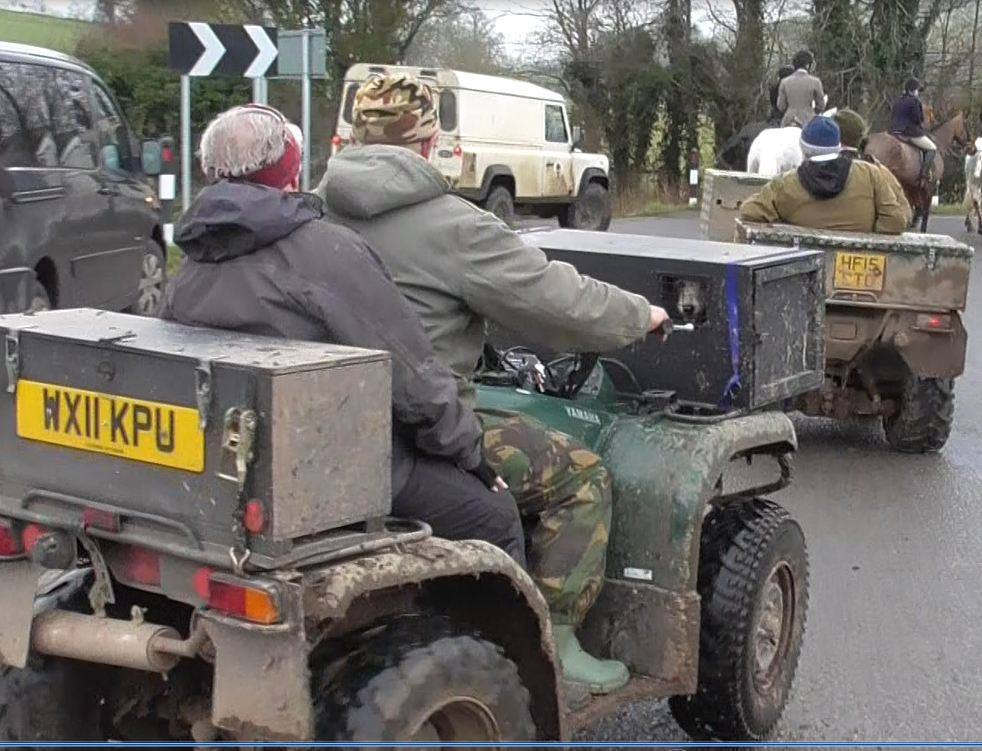 Terriermen armed with digging equipment and small dogs follow almost every pack of Foxhounds. No predator, or so-called predator, of foxes blocks their holes to keep them running 'on top' or digs them out if they do escape underground. Just one example of how foxhunting is anything but "natural". Portman Hunt, 2018. Photo credit: Wildlife Witness
Terriermen armed with digging equipment and small dogs follow almost every pack of Foxhounds. No predator, or so-called predator, of foxes blocks their holes to keep them running 'on top' or digs them out if they do escape underground. Just one example of how foxhunting is anything but "natural". Portman Hunt, 2018. Photo credit: Wildlife Witness
OPINION: Zoologist Jordi Casamitjana writes exclusively for Hounds Off
One of Mr. Barrington‘s favourite claims is that hunting with hounds is the equivalent of natural predation as the hunts play the role of the wolves, now extinct in the UK, which he claims are the natural predators of foxes. This is completely untrue, as actually there are no real natural predators of foxes and there have never been. Foxes are a predator species, not a prey species, and just because wolves are bigger it doesn’t mean that they normally predate on foxes. In this issue one can clearly see what happens when someone with no background in zoology or ecology tries to use zoological arguments (Mr. Barrington makes a basic error in assuming that the simplistic idea of the bigger fish always eats the smaller fish in the sea applies everywhere).
Although wolves may have occasionally eaten foxes that would be extremely rare and definitively does not make the fox the natural prey of the wolf, in the same way leopards are not the natural prey of lions, or wolves are not the natural prey of tigers, or coyotes are not the natural prey of pumas. You don’t see an increase of populations of these smaller predators when the larger predators population decreases (ie; tigers are endangered now), as such rare occasional kills (which tend to be accidental rather than a deliberate attempt to predate) are unlikely to have any significant population effect.
Wolves may kill and eat foxes in dispute over carcases, but foxes are fast and can easily hide when chased, so wolves would not normally go for them (beside wolves natural prey are ungulates as they are endurance hunters which need big mammals to feed the pack).
And just in case you are thinking of replacing wolves for lynxes (also extinct in the UK), the same applies. Although there have been reports of lynxes predating on foxes this is unlikely to apply in England and Wales where man-made hunting occurs as lynxes are ambush predators which would only managed to catch foxes in deep snow, where their legs and larger paws give them the advantage. This situation, when it could conceivably happen in wild areas in Scotland when there is deep snow, could not be compared to humans chasing a fox with a pack of hounds for a long time, then bolting it with a terrier when it hides in one of the holes that had not previously be blocked by terriermen the day before, and then the hounds continue the chase it until the whole thing happens again. This is a completely unnatural behaviour foxes would never experience in Nature before humans began hunting them for “sport”.
In Nature, nobody would have blocked the numerous hiding places the fox would have found, and nobody would have dig it out or bolt it out with a smaller predator that happens to hunt together with the wolves or the lynx.
Hunting with hounds is an unnatural man made practice and it does not replace any natural predation foxes would have evolved to deal with. Because of this foxes are not equipped to endure it and suffer great deal when hunted.
© Jordi Casamitjana
Zoologist
PREVIOUSLY
Hunting Myths Pt 1: The Snakeoil Salesman
Hunting Myths Pt 2: They Only Go For The Sick Old & Weak
Hunting Myths Pt 3: Hunting Is Efficient & Humane
8th December 2018
Hunting Myths Pt 3: Hunting Is Efficient & Humane
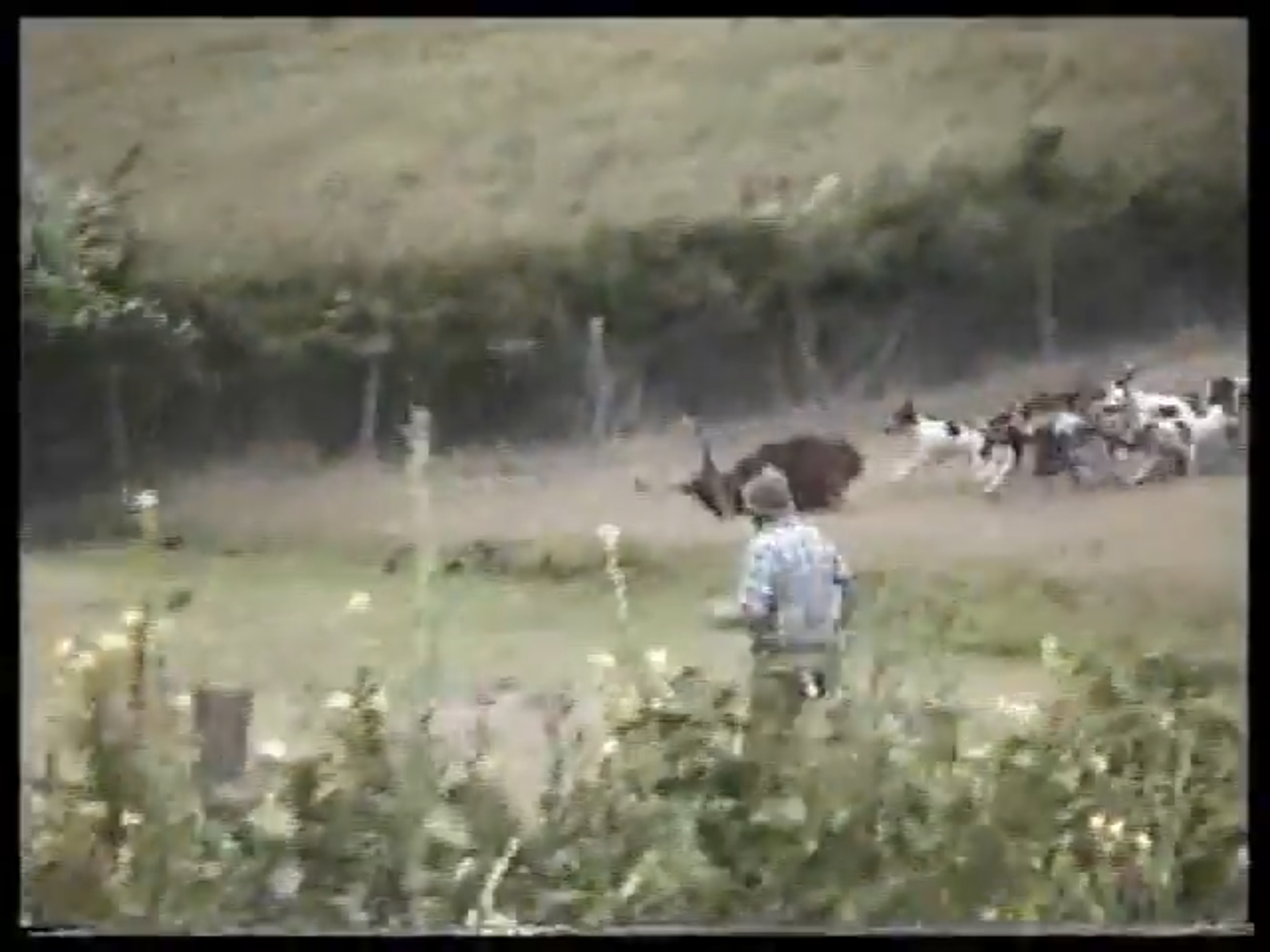 Nothing humane or quick about the hunting & killing of this healthy stag by the Quantock Stag Hounds on August 29th 1995. By definition, without the Hunting Act such atrocities would be legal. Stills grab from film taken by Kevin Hill.
Nothing humane or quick about the hunting & killing of this healthy stag by the Quantock Stag Hounds on August 29th 1995. By definition, without the Hunting Act such atrocities would be legal. Stills grab from film taken by Kevin Hill.
OPINION: Zoologist Jordi Casamitjana writes exclusively for Hounds Off
Mr Barrington claims (Horse & Hound, 11.10.18) that hunting causes less animal suffering than other ways to kill such as shooting. This is not true. He claims that shooters often miss and injure the animals they target (which is true and this is why shooting should also be banned) and so hunting is a better alternative. However, he completely omits three key facts:
1) Only in hunting you have the psychological and physical suffering caused by the prolonged chase, which Professor Bateson and Elizabeth L. Bradshaw famously proved with their undisputed research which led to the banning of staghunting in National Trust land many years ago (a ban which, unfortunately, the NT does very little to enforce).
2) The animals may also be injured by the hounds and not be killed straight away if they managed to hide underground on time or to flee into land the hounds cannot enter.
3) Dogs, like most canids (wolves, hyenas, etc.), would not kill their prey by a quick bite in the neck as felids (cats, tigers, etc.) do, but by biting any part of the body they can reach, and keep biting. Therefore, the actual death along (ignoring the suffering already caused by the long chase) is likely to cause lots of pain and suffering.
Need more proof? If a horse is fatally injured in a race, a dangerous animal escapes from a zoo, or diseased livestock needs to be put down, what is the “humane” method the authorities choose to kill the animal? Do they choose death by “dog bites”?
Mr Barrington often claims that hunting is the most efficient way to control foxes, deer and hare. This is a curious way to use the term “efficient”, as it actually means “achieving maximum productivity with minimum wasted effort or expense.” So, comparing it with other wildlife control activities (unfortunately still legal) such as shooting or snaring, how can it be more efficient?
Productivity wise - in this case meaning number of animals killed - a foxhunt will spend most of the day hunting an average of three or four foxes. Often some of these, if not all, get away. And the “wasted effort or expense” of this? Four or five paid hunt staff, dozens of paying filed riders, large vehicles to move the animals around, maintaining large pack of hounds, all the horses and their keep, expensive uniforms, and even all the policing due to allegations of illegal hunting, and public order issues when hunt saboteurs, hunt monitors or other witnesses are around … compared with a vehicle, a torch and a gun, or a stalker, or just a few snares. The most efficient, really? To be clear I think shooting, snaring and hunting should all be banned because they are all cruel and unnecessary. However, if they are ranked by efficiency, how anyone can seriously claim that hunting is the most efficient?
But let’s be generous and accept that there may be people out there who genuinely believe hunts are real “wildlife managers”. Well, it they want to call them like that then hunts are the least effective, least efficient and least humane wildlife managers in existence. So much so, that it almost looks like rather than be composed by ecologists, zoologist, veterinarians or anthropologists with a deep understanding of wildlife and the environment , they are composed by horse riders, bird shooters, dog breeders, livestock farmers, badger baiters and fox diggers. Oh wait … that’s why!
© Jordi Casamitjana
Zoologist
PREVIOUSLY
Hunting Myths Pt 1: The Snakeoil Salesman
Hunting Myths Pt 2: They Only Go For The Sick Old & Weak

